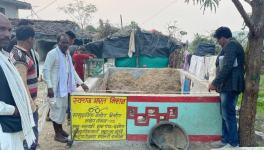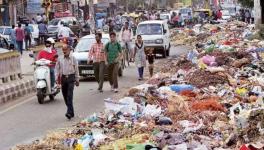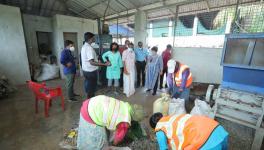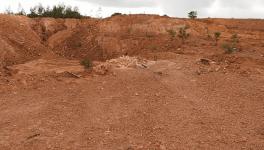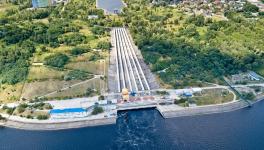Unsettling Proliferation of Solar PV Waste Piles and What it Means for us
With Prime Minister Narendra Modi pitching 500 GW as a target for energy production from renewable sources, mainly solar and wind, there has been a substantial increase in mega solar park installations across the country in various landscapes.
Blessed with the tropical sun with an estimated radiation potential of about 5,000 trillion kilowatt-hours per year (kWh/year), the speed at which solar panels are covering ground to drastically reduce reliance on fossil fuels is incredible. The target is to generate 50% of the country's energy demands from the renewable sector by 2030.
Consequently, several policies, programmes and schemes are being introduced back to back to facilitate easy and rapid solar energy production. The International Solar Alliance, set up in 2015, has played a key role in facilitating global partnerships to make this transition happen.
Pavagada, Badla, and other regions in Karnataka are indicative of the speed with which such massive utility-scale solar parks are set up. What is often not reported is that such transitions have not been without resistance: struggles by local communities who feel they have been hit by a renewable energy tsunami have been brushed under the carpet, and the effort is to project industry collaboration with parastatals through special purpose vehicles.
Financiers, state agencies and developers are forming collaborations on mission mode to install more and more such parks. In the process, land, including productive agricultural land and village commons, is taken over through negotiated persuasions, and sometimes also due to aggressive takeover, particularly of those communities who refuse to lease or sell their land.
The lack of agency among the locals is becoming their crucible as they fail to negotiate better deals for themselves, and given the blanket exemption for solar parks from Environmental Impact Assessment or EIA Notification (as these are considered environmentally beneficial), the impacts on local ecosystems, drainage patterns, etc. are entirely overlooked. The distress faced by small landholders and landless labourers, who are forced out of their survival ecosystems, is forcing them into acute food and livelihood insecurities and worsening their poverty.
While such structural problems remain unaddressed, India projects itself as a major global player in transitioning to solar-based power generation.
Meanwhile, a new problem largely unnoticed and certainly not discussed is that of unregulated disposal of solar photovoltaic (PV) waste. Driving through solar parks and conversations with locals reveal the scale and nature of this rapidly emerging challenge.
Since solar PV panels have a design life of 25 years, and since there are no major mechanical operations, it is presumed they will survive this design life. Only a small percentage of the panels end up as waste due to structural damage during transport and installation or even local natural calamities such as heavy rains, floods, etc. Thereby, there is not much effort invested in comprehending the challenge when all these panels will be redundant and considered waste in a quarter century!
If we consider the 13,000 acres of Pavagada Solar Park (Karnataka) in its construction phase - 2017-21, huge piles of dry waste centres sprung up almost all without a plan. The initial years during installation in Pavagada from 2017-21, one saw massive dry waste centres that processed all the recyclable cardboard, thermocol, bubble wrapping plastic, plastic tapes, metal binders and clips.
Farmers who had typically given their land on lease for the solar park also rented their land for such processing facilities where local people helped in sorting, piling and selling of the material that had some value. With the installation complete, these centres have been wound up and remain empty with decaying cardboard waste left to wither by the weather.
Now an alarming situation is mushrooming as the discarded panels are beginning to pile up, and there simply is, as yet, no plan on handling the humongous volume that will emerge sooner or later. PV waste constitutes glass panels with embedded circuitry, wiring, metals, binders, synthetic paints and glues, and also at the storage end inverters and battery systems. The chemicals involved are lead, cadmium, chromium, and many rare earth metals. Small piles of such waste have already begun to show up in the nooks and corners of solar parks, out of sight from a passer-by.
With park spaces surveilled under CCTV cameras and barbed fencing all around, it is highly unlikely that any of this waste is accessible to itinerant waste pickers. As there are no environmental regulations governing solar parks and their impacts, there appears to be, quite simply, no effort to deal with the massive volumes.
Needless to state, the necessary infrastructural or institutional competence required in handling this waste material flow, which can have an irreversible environmental and public health impact on the local environment, is simply absent at present.
What is most worrying about such a lack of a plan is that the waste will get piled up and remain unattended, resulting in the toxic chemical leaching out as the material breaks down. This will contaminate water, soil, and air, seriously impacting human life and biodiversity.
Local communities, stressed about lack of access to their land for an extended period of about 28 years, are waking up to the lack of other livelihood options and skills to be integrated in the wider economy. There simply has been no effort to build vocational training in such solar park development regions, which are now entirely dependent on casual labour.
The condition manifests itself through the lack of nutrition at the household level and mounting healthcare debts, for instance. When this solar waste piles up, these communities will be more vulnerable to the risks of the environmental contamination that would result from it. This will invariably increase their health burden and health expenditure, leaving them trapped in a vicious cycle of debt and poverty.
Solar power developers who were welcomed with a red carpet, and provided with a plug, install and generate power are unlikely to invest in the safe management of waste streams as their financial models do not comprehend the need. Sooner or later, depending on market trends, they may even rely on trading off these assets for the next big return on investments deal that will augment their wealth.
The promises of ‘developing’ the region are likely to be forgotten, as is quite often the situation of local villages displaced for industries. Considering that solar parks are out of the purview of EIA Notification, there appears to be, quite simply, no attention whatsoever to the long-term environmental impacts of the development.
All things considered, there is a critical need for widespread awareness of long-term risks of mounting PV and electronic waste when these massive plants are decommissioned. There is also an urgent requirement to build necessary protocols and skills in handling such waste, besides setting up research stations and proper waste handling for recovery of rare earths, metals and such other materials that could be recycled at the End of Life of PV waste.
The responsibility for this lies equally with the government’s energy and environment departments, and energy developers, so we do not end up having a situation where unscientific and illegal dumping of these panels will damage wetlands and forest patches in and around cities.
The writer is a Trustee/Senior Fellow at the Environment Support Group, which works with various environmental and social justice initiatives. The views are personal.
Get the latest reports & analysis with people's perspective on Protests, movements & deep analytical videos, discussions of the current affairs in your Telegram app. Subscribe to NewsClick's Telegram channel & get Real-Time updates on stories, as they get published on our website.









